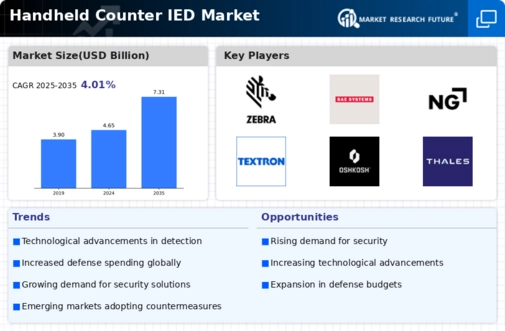Top Industry Leaders in the Handheld Counter IED Market

The handheld counter-IED (Improvised Explosive Device) market plays a pivotal role in enhancing the safety and security of military and law enforcement personnel. The competitive landscape of this market is characterized by key players employing strategic initiatives to establish dominance and cater to the evolving needs of defense and security forces.
Key Players:
Chemring Group PLC (UK)
Rapiscan Systems (US)
PKI Electronic Intelligence GmbH (Germany)
and Guartel Technologies Ltd (UK).
Strategies Adopted:
To navigate the competitive landscape effectively, companies in the handheld counter-IED market adopt various strategies. Product innovation, strategic partnerships, acquisitions, and a focus on customer relationships are key components of their approaches. For example, Northrop Grumman Corporation has consistently invested in R&D to develop cutting-edge technologies for its handheld counter-IED devices, enhancing its market appeal. Similarly, strategic partnerships between L3Harris Technologies and other defense contractors have resulted in collaborative efforts, allowing for a more comprehensive and integrated approach to countering IED threats.
Market Share Analysis:
The handheld counter-IED market is influenced by factors such as the performance and reliability of devices, adherence to industry standards, pricing competitiveness, and the ability to provide tailored solutions to end-users. Companies that excel in delivering effective, user-friendly, and technologically advanced handheld counter-IED devices are likely to secure a larger market share. Additionally, maintaining strong relationships with defense and security agencies is crucial for sustained market leadership.
News & Emerging Companies:
The handheld counter-IED market has seen the emergence of new players seeking to capitalize on the increasing demand for portable and efficient threat detection solutions. Companies like Tactical Countermeasures and SafeGuard Global have gained attention for their innovative approaches and agile responses to evolving security challenges. These emerging companies contribute to the market by introducing fresh perspectives and nimble solutions to address the dynamic nature of the counter-IED landscape.
Industry Trends:
The handheld counter-IED market, with a focus on technological advancements and integration capabilities. Companies are investing significantly in the development of artificial intelligence (AI) and machine learning (ML) technologies to enhance the detection accuracy and speed of their devices. Furthermore, there is a notable trend towards the integration of communication capabilities into handheld counter-IED devices, enabling seamless coordination and information sharing among security personnel. These investments signify a commitment to staying ahead of emerging threats and providing comprehensive solutions to end-users.
Competitive Scenario:
The handheld counter-IED market is marked by fierce competition among established players and the emergence of innovative newcomers. With the persistent threat of IEDs, companies strive to differentiate themselves by offering comprehensive solutions that address the evolving tactics of threat actors. Established players focus on consolidating their product portfolios, expanding their global footprint, and solidifying relationships with defense and security agencies. The entry of emerging companies injects dynamism into the market, fostering an environment of continuous innovation and adaptability.
Recent Development
The handheld counter-IED market witnessed a significant development as Thales Group secured a major contract for the supply of its advanced handheld counter-IED devices to a key military agency. The contract, valued at millions of dollars, includes the delivery of state-of-the-art devices equipped with enhanced detection capabilities and improved ergonomics. This development not only underscores the continued demand for effective handheld counter-IED solutions but also reinforces Thales Group's position as a trusted supplier in the market. The contract is expected to have a substantial impact on the company's market share and overall standing within the competitive landscape.











